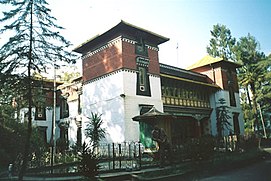 Entrance of the Institute building | |
|
| |
| Established | 1 October 1958 [1] |
|---|---|
| Location | Gangtok, Sikkim, India |
| Website |
tibetology |


Namgyal Institute of Tibetology (NIT) is a Tibet museum in Gangtok, Sikkim, India, named after the 11th Chogyal of Sikkim, Sir Tashi Namgyal. [2] The institute employs researchers and one of its new research programs is a project which seeks to document the social history of Sikkim's approximated 60 monasteries and record this on a computer. Another project seeks to digitize and document old and rare photographs of Sikkim for knowledge distribution. Khempo Dhazar served as head of the Sheda, a Nyingma college attached to the Institute, for six years. [3]
History
The foundation stone of the museum was laid by the 14th Dalai Lama on 10 February 1957. [4] On October 1, 1958, Pandit Jawaharlal Nehru, the then Prime Minister of India, inaugurated the Sikkim Research Institute of Tibetology. [5] Sir Tashi Namgyal, the then Maharaja of Sikkim, changed its name into the "Namgyal Research Institute of Tibetology". [6]
Academic journals
The Bulletin of Tibetology is an academic journal published by the Namgyal Institute of Tibetology. [7]
References
- ^ American University (Washington, D.C.). Foreign Areas Studies Division (1964). Area Handbook for Nepal (with Sikkim and Bhutan). U.S. Government Printing Office. pp. 372–.
- ^ Abhijeet Deshpande (19 December 2017). Backpacking North East India: A Curious Journey. Notion Press. pp. 228–. ISBN 978-1-946556-80-6.
- ^ Silverstone, Marilyn. "Five Nyingma Lamas in Sikkim" (PDF). pp. 13-.
- ^ Central Asia. Area Study Centre (Central Asia), University of Peshawar. 2006.
- ^ "Darbar Gazette: Royal Charter of Incorporation of the Sikkim Research Institute of Technology". Namgyal Institute of Tibetology, British Library: EAP880/1/1/240. Sikkim Palace Archives, Gangtok: Kingdom of Sikkim. 1959. p. 42. Retrieved 23 September 2022.
- ^ American Institute of Indian Studies (1980). American Institute of Indian Studies Quarterly Newsletter. American Institute of Indian Studies. pp. 37-.
- ^ "Digital Himalaya: Bulletin of Tibetology". Digital Himalaya. Retrieved 18 October 2023.
External links
- Official website
-
 Media related to
Namgyal Institute of Tibetology at Wikimedia Commons
Media related to
Namgyal Institute of Tibetology at Wikimedia Commons
27°18′57″N 88°36′17″E / 27.3159°N 88.6047°E